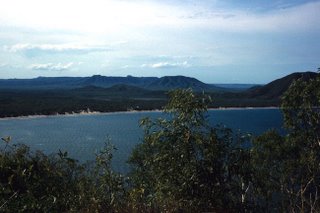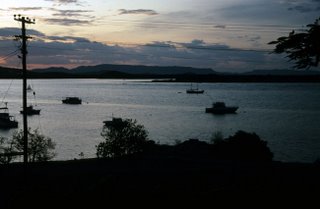At first it was the landscape that beckoned ... Lakefield National Park, the Quinkan rock art galleries, Undara's lava tubes. But gradually it became the people. Towns like Einasleigh, Cooktown and Laura were like Steinbeck novels—populated by likeable losers and dry-witted drunks. The further I went, the better the stories got.
John van Tiggelen, Mango Country
 Cooktown is at the end of the track. Almost. About 2000 km north of Brisbane, Cooktown is the largest town on Cape York Peninsula. And as journalist John van Tiggelen says, it's a town of character and of characters.
Cooktown is at the end of the track. Almost. About 2000 km north of Brisbane, Cooktown is the largest town on Cape York Peninsula. And as journalist John van Tiggelen says, it's a town of character and of characters.There are two roads in (and out, I suppose). The fastest is the Peninsula Developmental Road, which runs inland through a gently undulating landscape of savannah and open woodland. The road heads north to the tip of the Cape but Cooktown-bound travellers turn off at Lakeland. A more leisurely route is the Bloomfield Track, which cuts through coastal rainforest, much of it in the Wet Tropics World Heritage Area. The two roads join just north of Helenvale.
 Cooktown has a long European history. (European readers, remember that 'long' is relative in Australia.) In 1770, Captain James Cook beached HMS Endeavour at the mouth of the river to repair the hull after it was damaged on the reef. Naturalists Joseph Banks and Daniel Solander wandered off to collect specimens. This is the place where the word 'kangaroo' was first recorded.
Cooktown has a long European history. (European readers, remember that 'long' is relative in Australia.) In 1770, Captain James Cook beached HMS Endeavour at the mouth of the river to repair the hull after it was damaged on the reef. Naturalists Joseph Banks and Daniel Solander wandered off to collect specimens. This is the place where the word 'kangaroo' was first recorded.Since Banks and Solander collected material there, many biologists have visited the area. According to CYPLUS (Cape York Peninsula Land Use Study), Cooktown and the Endeavour River are type localities for 79 species of animals and 11 species of plants. That information is way out of date (the report was compiled in 1995). No doubt many more species have been described from the region.
Cooktown isn't on the tourist map in the same way as the Daintree or Port Douglas but I like it. It's a world apart. Once a gold town (it sprung up in October 1873 when two boatloads of miners arrived to work the Palmer River gold fields), its fortunes followed that of the mines. It declined in the early 1900s as the gold ran out.
Despite regular cyclones, many of the old buildings remain. Cooktown is undergoing a resurgence. Visit while it's still authentic.
 James Cook Museum
James Cook MuseumSt Mary's Convent (founded 1888) is now the James Cook Museum. First a school, then a U.S. Army base during World War II, the building was abandoned after the war. It was all but flattened by a succession of cyclones. The convent was restored and opened as the James Cook Museum in 1970. (That's a James Cook University vehicle outside the James Cook Museum.)
The tragic tale of Mrs Watson
Captain Watson fished for beche-de-mer (sea cucumber) in the waters of the Coral Sea. He and his family lived on Lizard Island, where they were attended by Chinese servants. The good cap'n headed off to get his haul of beche-de-mer, leaving wife and baby son behind. What they hadn't counted on was the wrath of the local Dingaal people, to whom the island was a sacred bora ground. Mrs Watson, son Ferrier and servant Ah Sam escaped in an iron tank, which had been used to boil up beche-de-mer.
 They landed at one of the Howick group but found no water, so moved on to another island. That was also dry. Slowly, the three of them died of thirst. They are buried in Cooktown Cemetery. Mrs Watson's death is commemorated in a memorial drinking fountain in the main street. (Shades of the Harold Holt Swimming Pool there.)
They landed at one of the Howick group but found no water, so moved on to another island. That was also dry. Slowly, the three of them died of thirst. They are buried in Cooktown Cemetery. Mrs Watson's death is commemorated in a memorial drinking fountain in the main street. (Shades of the Harold Holt Swimming Pool there.) (Incidentally, the tank is in the collection of the Museum of Tropical Queensland, Townsville. I'm not sure if it's still on display. The tank is perforated with lots of small holes. Rust? Nope. When the group's remains were found several months later, the tank was full of rain water. The recovery party had to knock holes through the iron to let the water out.)
(Incidentally, the tank is in the collection of the Museum of Tropical Queensland, Townsville. I'm not sure if it's still on display. The tank is perforated with lots of small holes. Rust? Nope. When the group's remains were found several months later, the tank was full of rain water. The recovery party had to knock holes through the iron to let the water out.)